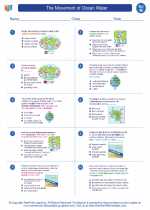Bone
Bones are rigid organs that form the endoskeleton of vertebrates. They provide support, protect vital organs, and facilitate movement. Bones are composed of both organic and inorganic materials, including collagen, calcium, and phosphate.
Structure of Bone
Bone tissue is composed of cells and extracellular matrix. The primary bone cells include osteoblasts, osteocytes, and osteoclasts. Osteoblasts are responsible for bone formation, osteocytes are mature bone cells that maintain the bone tissue, and osteoclasts are involved in bone resorption.
The extracellular matrix of bone consists of collagen fibers, which provide flexibility, and mineral salts, mainly calcium and phosphate, which provide hardness and rigidity.
Types of Bones
There are two main types of bone tissue: compact bone and spongy (cancellous) bone. Compact bone is dense and forms the outer layer of bones, providing strength and support. Spongy bone is less dense and is found at the ends of long bones and in the interior of flat and irregular bones.
Bone Development and Growth
Bones develop through a process called ossification, which involves the deposition of minerals and the formation of the bone matrix. Long bones grow in length at the epiphyseal plate, a cartilaginous region at the ends of bones. This process is regulated by hormones, such as growth hormone and sex hormones.
Functions of Bones
Bones serve several important functions in the body, including:
- Support and framework for the body
- Protection of vital organs
- Facilitation of movement through the attachment of muscles
- Storage of minerals, such as calcium and phosphate
- Production of red and white blood cells in the bone marrow
Common Bone Disorders
Some common bone disorders include osteoporosis, a condition characterized by low bone density and increased risk of fractures, and osteoarthritis, a degenerative joint disease that affects the cartilage in the joints.
Study Guide
To study the topic of bones, consider the following key points:
- Understand the structure and composition of bone tissue, including the roles of osteoblasts, osteocytes, and osteoclasts.
- Learn about the types of bone tissue, their locations in the body, and their functions.
- Explore the process of bone development and growth, including the role of hormones and the mechanisms of bone elongation.
- Identify and understand the various functions of bones in the human body.
- Investigate common bone disorders and their impact on overall health.
By mastering these concepts, you will develop a comprehensive understanding of the structure, function, and significance of bones in the human body.
.◂Science Worksheets and Study Guides Eighth Grade. The Movement of Ocean Water

 Worksheet/Answer key
Worksheet/Answer key
 Worksheet/Answer key
Worksheet/Answer key
 Worksheet/Answer key
Worksheet/Answer key
 Vocabulary/Answer key
Vocabulary/Answer key
 Vocabulary/Answer key
Vocabulary/Answer key
